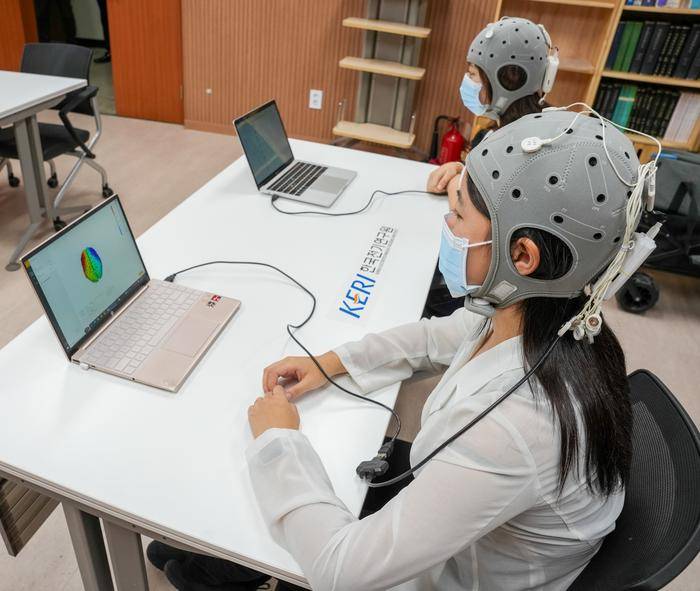A team of researchers from the Korea Electrotechnology Research Institute (KERI) and Seoul National University Hospital has demonstrated that a non-invasive brain stimulation technique could effectively reduce appetite and emotional eating. The study marks a significant step towards developing alternative treatments for obesity and metabolic syndrome.
Tackling the Global Obesity Crisis
Obesity has become a worldwide epidemic, with the World Health Organization (WHO) reporting that one in eight people globally is overweight. This health crisis has spurred research into various treatment options, including pharmaceuticals and surgical interventions. However, many of these approaches come with potential side effects, especially when used long-term.
Dr. Ki-young Shin of KERI’s Human Care Electro-Medical Device Research Center has proposed a novel solution: using electrical stimulation to suppress appetite by targeting specific areas of the brain. This approach, known as transcranial random noise stimulation (tRNS), aims to modulate brain activity without the need for invasive procedures or long-term medication use.
The Science Behind Brain Stimulation for Appetite Control
The research team focused on stimulating the dorsolateral prefrontal cortex, a region of the brain associated with executive function, planning, and impulse control. By applying a weak electrical current to this area through electrodes placed on the scalp, the researchers hypothesized that they could influence eating behaviors.
Dr. Shin explained the complexity of the technology: “Three key technologies are required for such studies. A technology that can accurately deliver the right electrical stimulation to the specific area of interest, an electrode technology that can penetrate into the space between the hairs and make contact with the scalp, and a monitoring technology that can confirm that the electrical stimulation has been delivered to the target point and has triggered a change in brain activity.”
To test their hypothesis, the team conducted a clinical trial in collaboration with Professor Hyung-jin Choi at Seoul National University Hospital. The study involved 60 female volunteers, split evenly between a treatment group receiving tRNS and a control group receiving a sham treatment. Participants underwent six 20-minute sessions over two weeks, with a barely perceptible current of 2 mA applied during each session.
The results were promising. The tRNS treatment group showed significant reductions in appetite, willingness to eat, and hunger compared to the placebo group. Notably, the treatment also appeared to help with emotional eating, reducing the tendency to eat in response to stress, depression, anxiety, or joy.
While the short duration of the trial didn’t allow for assessment of long-term weight loss, participants reported significant appetite suppression. Dr. Shin commented on the potential implications: “Although the technology is not yet complete and needs further research and verification, if this electrostimulation treatment equipment with far fewer side effects than existing obesity treatments is commercialized and can be used at home instead of in hospitals, it will provide an easy and simple method for daily appetite suppression management.”
Why it matters: With obesity rates climbing worldwide and existing treatments often accompanied by side effects or high costs, this non-invasive approach could offer a more accessible and manageable solution for millions struggling with weight control. Moreover, by targeting emotional eating, the technique addresses a common barrier to successful weight management that many other treatments overlook.
The study raises several important questions for future research:
1. How long do the appetite-suppressing effects last after treatment?
2. Could combining tRNS with other interventions, such as diet and exercise, enhance weight loss outcomes?
3. Are there any long-term effects or potential risks associated with repeated use of this technology?
As the research team moves forward, they plan to complete the first phase of their project this year and proceed with follow-up studies to further validate the technology both academically and clinically. The ultimate goal is to refine the technique for potential technology transfer to companies that could develop home-use devices.
Dr. Shin envisions a future where this technology could be integrated into comprehensive health management systems: “Especially when people are under stress or difficulty, many people eat food due to emotional hunger, and if digital healthcare technology that combines electrostimulation treatment and exercise therapy is introduced, it will enhance weight loss effects and help individuals manage their health more effectively.”
While the results are encouraging, it’s important to note that larger, longer-term studies will be necessary to fully understand the efficacy and safety of tRNS for appetite suppression. Additionally, regulatory approval and further refinement of the technology will be required before any commercial applications can be considered.


